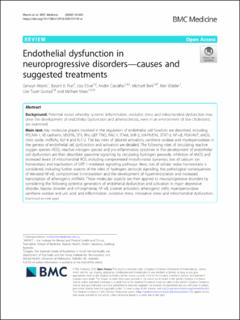| dc.description.abstract | Background
Potential routes whereby systemic inflammation, oxidative stress and mitochondrial dysfunction may drive the development of endothelial dysfunction and atherosclerosis, even in an environment of low cholesterol, are examined.
Main text
Key molecular players involved in the regulation of endothelial cell function are described, including PECAM-1, VE-cadherin, VEGFRs, SFK, Rho GEF TRIO, RAC-1, ITAM, SHP-2, MAPK/ERK, STAT-3, NF-κB, PI3K/AKT, eNOS, nitric oxide, miRNAs, KLF-4 and KLF-2. The key roles of platelet activation, xanthene oxidase and myeloperoxidase in the genesis of endothelial cell dysfunction and activation are detailed. The following roles of circulating reactive oxygen species (ROS), reactive nitrogen species and pro-inflammatory cytokines in the development of endothelial cell dysfunction are then described: paracrine signalling by circulating hydrogen peroxide, inhibition of eNOS and increased levels of mitochondrial ROS, including compromised mitochondrial dynamics, loss of calcium ion homeostasis and inactivation of SIRT-1-mediated signalling pathways. Next, loss of cellular redox homeostasis is considered, including further aspects of the roles of hydrogen peroxide signalling, the pathological consequences of elevated NF-κB, compromised S-nitrosylation and the development of hypernitrosylation and increased transcription of atherogenic miRNAs. These molecular aspects are then applied to neuroprogressive disorders by considering the following potential generators of endothelial dysfunction and activation in major depressive disorder, bipolar disorder and schizophrenia: NF-κB; platelet activation; atherogenic miRs; myeloperoxidase; xanthene oxidase and uric acid; and inflammation, oxidative stress, nitrosative stress and mitochondrial dysfunction.
Conclusions
Finally, on the basis of the above molecular mechanisms, details are given of potential treatment options for mitigating endothelial cell dysfunction and activation in neuroprogressive disorders. | en_US |

